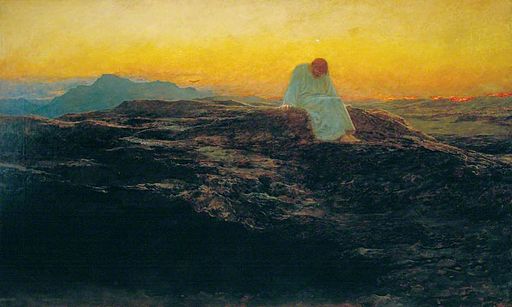Jesus was led by the Spirit out into the wilderness to be tempted by the devil. He fasted for forty days and forty nights, after which he was very hungry, and the tempter came and said to him, ‘If you are the Son of God, tell these stones to turn into loaves.’ But he replied, ‘Scripture says:
Man does not live on bread alone
but on every word that comes from the mouth of God.’The devil then took him to the holy city and made him stand on the parapet of the Temple. ‘If you are the Son of God,’ he said, ‘throw yourself down; for scripture says:
He will put you in his angels’ charge,
and they will support you on their hands
in case you hurt your foot against a stone.’Jesus said to him,
‘Scripture also says: You must not put the Lord your God to the test.’Next, taking him to a very high mountain, the devil showed him all the kingdoms of the world and their splendour. ‘I will give you all these’, he said, ‘if you fall at my feet and worship me.’ Then Jesus replied, ‘Be off, Satan! For scripture says:
You must worship the Lord your God,
and serve him alone.’Then the devil left him, and angels appeared and looked after him.
Mt 4:1-11
Jesus’ forty days in the desert (Mt 4:1-11; Lk 4:1-13) provides the Scriptural foundation for the Liturgical Season of Lent, a time of penance and great spiritual renewal. Just as Jesus took time to prepare himself for the beginning of his public ministry we use Lent as a form of penitential preparation for the great celebration of Easter. Central to this preparation is that we “repent, and believe the Good News”, i.e. we have a conversion of heart.
Amidst the busyness of our lives it is paramount that we slow down to recognize the need for such a conversion. All too frequently we are oblivious to our shortcomings and the impact that they have on others; we are often unaware that God has been “forgotten” by us, and our relationship with him neglected. Lent is not only a time of penance and preparation, it is a time of prayer, a time to “be still and know that I am God” (Psalm 46:10).
Jesus’ time in the desert models this for us. He sought aloneness to reflect, to pray, to be with his Father, and to prepare for the events ahead of him. In itself this paralleled with Moses’ forty days in the wilderness (Deut 9:9), a time of fasting, and of preparing to receive God’s revelation in the Ten Commandments. Throughout the Scriptures, both Hebrew and Christian, we are constantly reminded of the centrality of prayer to spiritual renewal.
Just as Jesus’ 40 days in the desert served as a preparation for his mission, ministry and suffering it serves as a model for the way in which our Lenten journey can be a time of or spiritual renewal and preparation for true Christian discipleship.
Anthony Cleary,
Director, Mission and Identity
